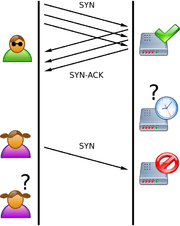A broadcast server is a server capable of duplicating a message and sending it to all machines present on the same network. The "smurf" technique is based on the use of broadcast servers to paralyze a network
The scenario of such an attack is as follows:
- the attacking machine sends forged packets that contain the spoofed source address of the attacker's intended victim (i.e. providing the IP address of a target machine) to one or more broadcast servers.
- the broadcast server passes on the request to the entire network
- all of the network's machines send a response to the broadcast server
- the broadcast server redirects the responses to the target machine.

In this way the bulk of the attacker's work involves finding a list of broadcast servers and falsifying the response address in order to direct them to the target machine.









